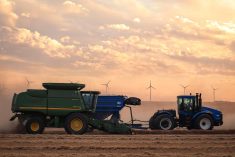MarketsFarm – When Toban Dyck started to plant his 600-plus acres of soybeans this year, the soil in the Winkler, Man. area had pretty decent moisture content. But following the combination of hot temperatures and strong winds with little rainfall in May, precipitation is now much needed.
“There’s still a little bit of moisture there. [During] these hot, windy days everything dries so quickly. A nice rain would be wonderful,” he said.
Read Also

Brazil to reap record soy crop in 2025/2026, increase exports
Brazil’s Conab said the country will reap a record soybean crop of 177.6 million tons in the 2025/2026 harvest year, according to data released on Thursday.
Dyck, who was the communications director for Manitoba Pulse and Soybean Growers and now the principal of the Burr Forest Group, noted the pace of spring planting in Manitoba’s Red River Valley region had noticeably picked up after a later than usual start.
“It looked like it was going to be a late spring. We’re finished seeding,” he said in an interview Tuesday; his soybeans went into the ground a couple of weeks ago.
“Last year we finished on June 9,” he added.
From what Dyck surmised, the amount of acres seeded with soybeans, as well as pulses, has increased this year, at least in the valley region.
“One indicator of that is how busy the implemented dealers are renting out their rollers. The waiting lists are long,” he said.
Manitoba Agriculture pegged soybean planting at 90 per cent province wide as of Tuesday. As for the central region, the department placed soybeans at the V1 stage with rolling continuing on some fields. Other areas of the province were 75 to 95 per cent done planting.
Another issue Dyck pointed out that posed a challenge this spring was fertilizer. Not so much its overall supply but rather getting it to the fields, as suppliers seemed to be short on trucks to move product to where farmers needed it. That may have led to farmers switching from other crops to soybeans, he said.
As farmers prepared for spring planting Statistics Canada projected Manitoba soybean acres at about 1.56 million, well up from last year’s 1.13 million.
— Glen Hallick reports for MarketsFarm from Winnipeg.















